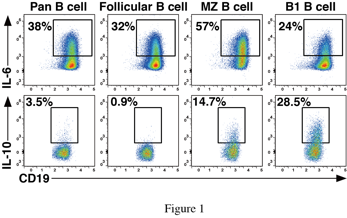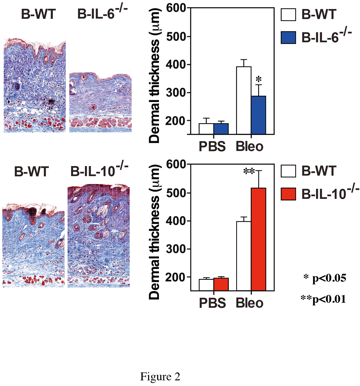Session Information
Session Type: ACR Poster Session A
Session Time: 9:00AM-11:00AM
Background/Purpose: IL-10-producing regulatory B (Breg) cells negatively regulate autoimmune diseases. We reported that Breg cells play a protective role in a mouse model of systemic sclerosis (SSc) and in patients. Recent studies indicate that IL-6-producing effector B (Beff) cells have pathogenic effect in autoimmune diseases. IL-6 plays a critical role for the pathogenesis of SSc, and a phase III trial of anti-IL-6R antibody (tocilizumab) is ongoing in patients with SSc. However, the phenotype and function of IL-6-producing Beff cells remains unclear. In this study, we investigated the phenotype of IL-6-producing Beff cells and their role in SSc pathogenesis.
Methods: B cell subsets were sorted and cytokine production was measured by intracellular cytokine staining. We generated mixed bone marrow chimeric mice with a B cell_specific deficiency in IL-6 or IL-10 production (B-IL-6-/- or B-IL-10-/-), together with control chimeras (B-WT). Skin fibrosis was assessed 4 weeks after the initiation of bleomycin treatment in mixed bone marrow chimeric mice.
Results: Most splenic IL-6 producing Beff cells were detected within the marginal zone (MZ) B cell subset, while IL-10-producing Breg cells were detected within the MZ B and B1 B cell subsets, but not within the follicular B cell subset (Fig 1). Serum IL-6 levels gradually increased with the development of fibrosis in bleomycin-induced scleroderma mice, while serum IL-10 levels did not. In addition, the frequency of splenic IL-6-producing Beff cells in bleomycin-treated mice was significantly increased. The bleomycin-induced skin fibrosis was attenuated in B-IL-6-/- mice compared with that in B-WT mice. In contrast, B-IL-10-/- mice showed more severe skin fibrosis than B-WT mice (Fig 2).
Conclusion: IL-6-producing Beff cells play a pathogenic role in bleomycin-induced scleroderma model, while IL-10-producing Breg cells play a protective role (Fig 3). Thus, B cells have reciprocal roles in SSc pathogenesis, presenting pathogenic and protective functions.
To cite this abstract in AMA style:
Matsushita T, Hamaguchi Y, Hasegawa M, Fujimoto M, Takehara K. Reciprocal Regulation of B Cells on Bleomycin-Induced Scleroderma Model: IL-6-Producing Effector B Cells Play a Pathogenic Role, While IL-10-Producing Regulatory B Cells Play a Protective Role [abstract]. Arthritis Rheumatol. 2017; 69 (suppl 10). https://acrabstracts.org/abstract/reciprocal-regulation-of-b-cells-on-bleomycin-induced-scleroderma-model-il-6-producing-effector-b-cells-play-a-pathogenic-role-while-il-10-producing-regulatory-b-cells-play-a-protective-role/. Accessed .« Back to 2017 ACR/ARHP Annual Meeting
ACR Meeting Abstracts - https://acrabstracts.org/abstract/reciprocal-regulation-of-b-cells-on-bleomycin-induced-scleroderma-model-il-6-producing-effector-b-cells-play-a-pathogenic-role-while-il-10-producing-regulatory-b-cells-play-a-protective-role/



